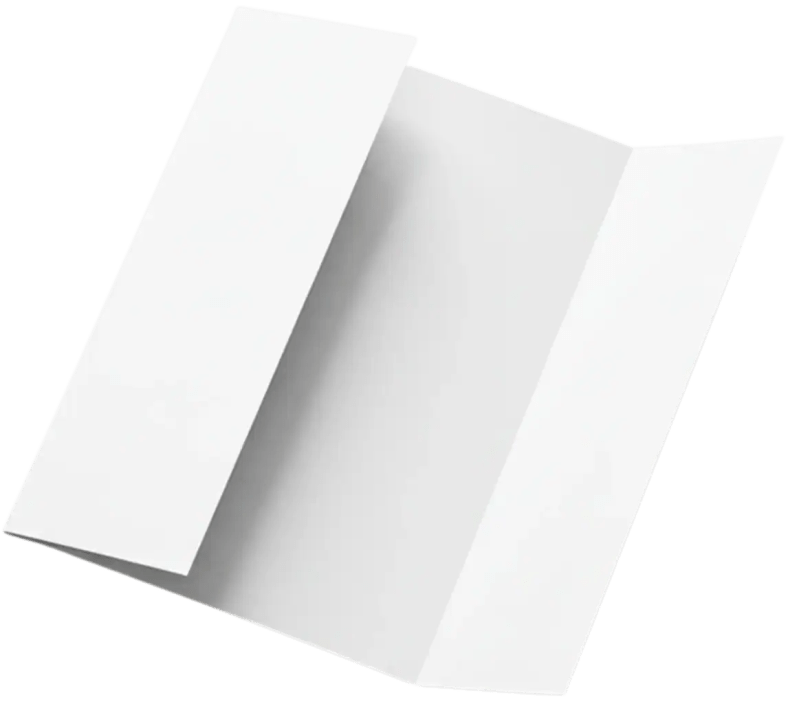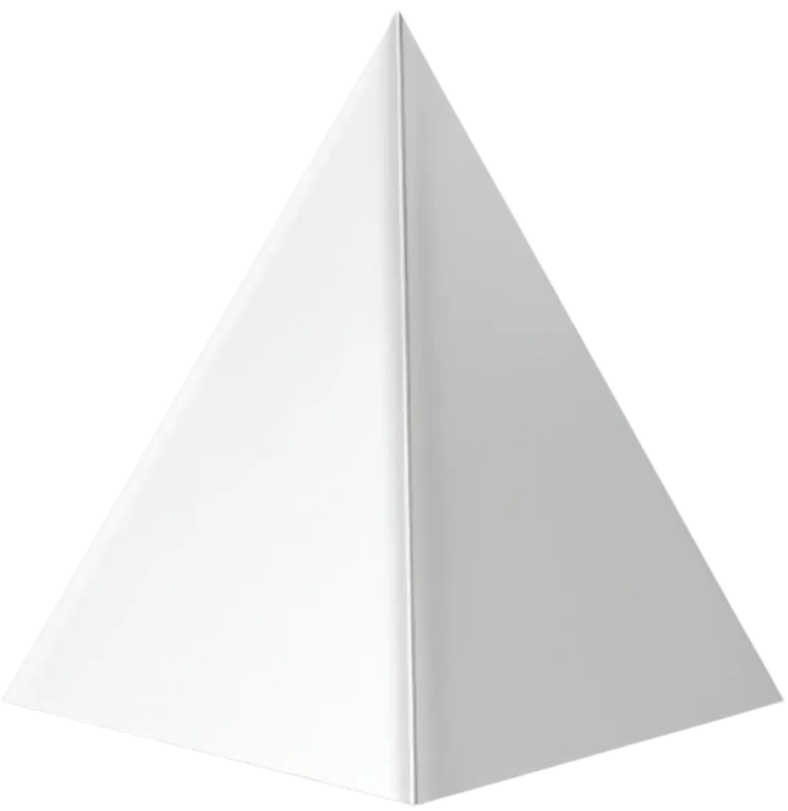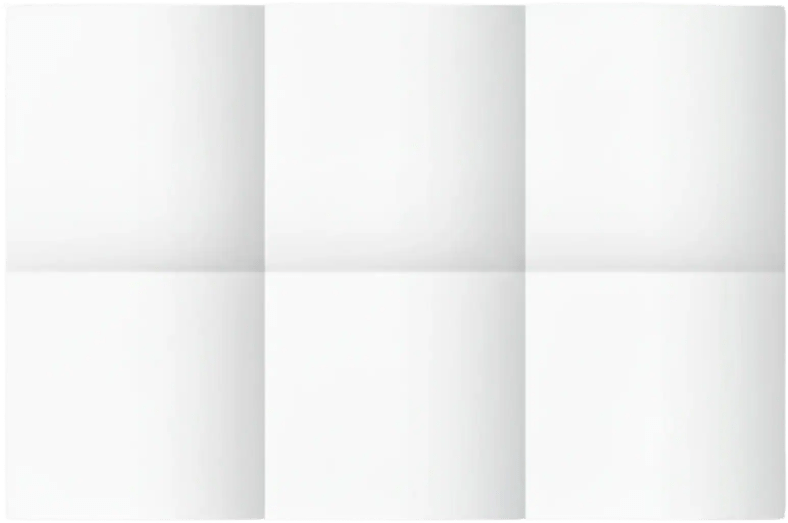Brochures are one of the surest ways to showcase your products or services in an impactful, memorable way.
But not all brochures are equal.
Brochures are one of the most flexible print products available as they can be adapted for whatever purpose you need them for.
Brochures stand apart from flyers and posters due to their defining characteristics: the fold. This interactive element makes brochures more engaging for customers and offers a superior way to compartmentalize your service efficiently.
We’ve created a guide to the most popular brochure folds to help you choose the best one for your print marketing, ensuring maximum ROI, sales conversions, and the effectiveness of your printing marketing strategy.
Types of Brochures & Folds: Key Highlights
- Brochure Folds: We explore 15 different types of brochure folds, categorized into fold-based, accordion & multi-page, and specialty & custom.
- Graphic Design Tips: We cover key design considerations like bleed, trim, safety area, and general design principles to ensure print quality.
- Paper and Finish: We discuss the importance of paperweight (text stock vs. card stock) and various coatings (gloss, matte, specialty) for the brochure’s final look and feel.
15 Types of Brochures & Folds
Investing in professional graphic design is a priority for many businesses.
For example, 19% of them are spending more than $10,000 per year to ensure their marketing materials stand out where one of the main areas that investment pays off is in printed brochures.

Each brochure type offers a unique way to deliver detailed information to potential customers, especially those who have already shown interest in a product or brand. Their versatile structure allows for creative design with endless variations in size, content and purpose.
By incorporating eye-catching colors, powerful text, and innovative design, brochures can effectively present further details, unlike, for example, a poster.
Here’s an overview of all the most common types of brochures in one table:
| Brochure Type | Key Features | Primary Use Cases |
| Bi-Fold (Half-Fold) | 1 fold, 4-page booklet | Telling a story, highlighting key messages about your event or product |
| Tri-Fold (Letter Fold) | 2 folds, good for breaking up information | Trade fairs, doctor’s offices, museums, hotels, real estate agencies, restaurants |
| Z-Fold | Z-shape when opened, continuous information flow | Timelines, step-by-step guides, showcasing products at trade shows |
| Accordion Fold | Folds back and forth like a fan, 3+ panels | Step-by-step guides, timelines, long visual narratives |
| Gate Fold | Outer panels fold inward, reveals large central panel | High-impact product launches, luxury branding, showcasing impressive visuals |
| Double Gate Fold | Gate fold with additional vertical fold, more surface area | Branding, content, and imagery |
| French Fold (Cross Fold) | Folds horizontally then vertically, 8 panels, large display area | Invitations, greeting cards, promotional maps, marketing material that benefits from a surprising reveal or a large interior graphic |
| Roll Fold | 4+ panels fold inward to width of single panel | Comprehensive guides, tutorials, service menus where information needs to be presented in a logical, unfolding sequence |
| Double Parallel Fold | All folds parallel, folded in half twice, around 8 panels | Detailed marketing materials, reference pieces, product lists, service catalogs, general informational brochures |
| Quarter Fold | Folds vertically and horizontally at 90-degrees, 4 equal panels | Event programs, greeting cards, promotional materials where a simple yet refined presentation is preferred |
| Map Fold | Parallel and perpendicular folds, large display area when unfolded | Tourist maps, large-scale posters, detailed event guides |
| Mailing Fold | Designed as a “self-mailer,” meets postal regulations, wafer seal/tab | Direct mail campaigns |
| Step Fold | Accordion fold with different panel widths, cascading effect | Visually indexing content, step-by-step guides |
| Pyramid Fold | Custom die-cuts and scoring, folds into 3D pyramid | High-end invitations, product launches, memorable and stand out material |
| Combination Fold | Merges two folding styles, versatile structure for varied content types | Creative marketing pieces, product catalogs, informational brochures that benefit from distinct visual groupings |
Fold-Based Brochures
The most common brochure types are fold-based brochures that are single sheets of paper that are folded together to create different panels.
There is a large variety of different folds that are suitable for different use cases and are the most common offered by printing companies.
1. Bi-Fold (Half-Fold)
The bi-fold or half-fold brochure is the simplest type. Created by folding a single sheet of paper in half, creates a four-page booklet to put information on all 2 panels.
The two interior pages are ideal for telling a story of highlighting key messages about your event or product:

2. Tri-Fold (Letter Fold)
The tri-fold brochure is the classic brochure that you will find at trade fairs, doctor’s offices, museums, hotels, real estate agencies, and of course restaurants.
It’s the fold that allows for a good deal of information that can be broken up neatly to give a powerful summary of what your company offers.

Also, here’s a video showcasing how to fold paper for tri-fold brochures:
3. Z-Fold
The Z-fold brochure forms a Z-shape when opened creating a continuous flow of information.
This design is excellent for presenting information in a sequential manner, making it ideal for timelines, step-by-step guides, or showcasing products at trade shows:

4. Accordion Fold
The accordion fold is a versatile style created by folding a single sheet of paper back and forth, much like a fan.
This common method typically creates three or more panels that fold out into a long, continuous display:

This format is perfect for presenting information sequentially, making it ideal for step-by-step guides, timelines, and long visual narratives.
5. Gate Fold
A gate fold features two outer panels that fold inward to meet in the middle like a pair of gates.
When opened, it reveals a larger impactful central panel, perfect for showcasing impressive visuals.

6. Double Gate Fold
Another variation of the gate fold is the double gate fold, where there is an additional vertical fold.
This creates a gate fold that’s then folded in half, providing even more surface area for branding, content, and imagery:

7. French Fold (Cross Fold)
The french fold (or cross fold) involves folding a single sheet of paper in half horizontally and then in half again vertically.
This creates a compact brochure with eight panels, which opens to a large, single display area:

It’s a versatile option for invitations, greeting cards, promotional maps, or any marketing material that benefits from a surprising reveal or a large interior graphic.
Design your custom brochure today.

8. Roll Fold
A roll fold brochure usually has four or more panels that fold inward to be the width of a single panel.
The roll fold is ideal for comprehensive guides, tutorials, or service menus where information needs to be presented in a logical, unfolding sequence.

9. Double Parallel Fold
A double parallel fold is where all the folds are parallel to each other. The paper is first folded in half and then folded again in the same direction.
This creates around 8 panels on which content can be presented:

Double parallel folds are great for detailed marketing materials or reference pieces.
They offer more space than a tri-fold while maintaining a clean, straightforward layout that’s ideal for product lists, service catalogs, or general informational brochures.
10. Quarter Fold
The quarter fold creates four equal panels by folding the sheet once vertically and once horizontally at a 90-degree angle.
The result is a compact, booklet-style layout that opens naturally and neatly. It’s often used for event programs, greeting cards, or promotional materials where a simple yet refined presentation is preferred.

11. Map Fold
The map fold uses a combination of parallel and perpendicular folds to turn a large sheet of paper into a compact, portable document.
When unfolded, it reveals a single, large display area, making it ideal for tourist maps, large-scale posters, or detailed event guides.

12. Mailing Fold
A mailing fold is any brochure style, often a tri-fold or bi-fold, that is designed to be sent as a “self-mailer” without an envelope.
The panels are folded to meet postal regulations and are often secured with a wafer seal or tab, making it a cost-effective choice for direct mail campaigns.

13. Step Fold
The step fold, also known as a stepped accordion, is a variation of an accordion fold where the panels have different widths.
This creates a cascading or “stepped” effect when folded, allowing the edge and title of each section to remain visible, which is perfect for visually indexing content or step-by-step guides.

14. Pyramid Fold
The pyramid fold is a creative specialty fold that requires custom die-cuts and scoring to achieve its shape. It’s designed to fold into a three-dimensional pyramid, adding an interactive “wow” factor.
This unique format is ideal for high-end invitations, product launches, or any material designed to be memorable and stand out.

15. Combination Fold
A combination fold is a hybrid layout that merges two different folding styles, such as a bi-fold and a tri-fold.
This creates a versatile structure that can accommodate varied sections or content types within the same brochure:

The combination fold is an adaptable choice for creative marketing pieces, product catalogs, or informational brochures that benefit from distinct visual groupings.
2026 Graphic Design Tips for Different Brochure Folds
Each brochure fold has their own technical considerations when it comes to the graphic design.
Bleed, trim, and safety area vary enormously so that when printed, the brochure can be cut and folded in the right way.
Here are some design tips for different brochure folds:
Bleed
The bleed prevents an unwanted white sliver from appearing on the final product if the cut is a bit off.
A standard bleed is 1/8″ on all four outer sides of a flat, unfolded sheet. Your design’s background color or image must extend this far beyond the final cut edge.
Fold Specific Tips:
- For All Folds: The bleed only goes on the four outer edges of the entire unfolded sheet. You never add bleed to internal fold lines for brochures.
- For All Folds: You set up your file as one large, flat sheet (e.g., 11″ x 8.5″). You then add a 1/8″ bleed to all four outside edges of that sheet, making your final file dimensions 11.25″ x 8.75″.
- Scorning: Since folds are created by scorning (creasing the paper), there is not as much risk of a cutting error.
Read more in our complete guide to Print Bleed!
Trim
The trim is the actual final and finished edge of your brochure after it has been cut out.
All your panel measurements and safety areas need to be based on this trim line.
Fold-Specific Tips:
- Tri-Fold: The three panels are not the same size. The “inner” panel (the one that folds in) must be physically narrower (e.g., 1/106″ or 21.5-3mm) than the other two panels to tuck inside without buckling.
- Z-Fold (Accordion Fold): All three panels are the same size.
- Half-Fold (Bi-Fold): The two panels are identical (e.g., 11″ x 8.5″ sheet is folded into two 5.5″ x 8.5″ panels).
- Gate Fold: The panels are not the same size. The two outer “gate” panels that fold in are smaller, typically half the width of the large central panel.
It’s important to note that the panel sizes themselves will be different depending on the fold.
Safety Area
The safety area, sometimes referred to as the margin, is the inner safe zone (different from the bleed, which is outer).
The safety area is typically set 1/8 inch inside the trim line and away from any fold lines.
Fold-Specific Tips:
- Fold Lines: Treat every fold line as a new safety margin. Do not place small text, logos, or a person’s face directly on a fold.
- Tri-Fold & Z-Fold: Be mindful of all internal folds. Keep text at least 1/8″ away from them.
- Half-Fold: It’s common to run a large photo across the inside spread, but avoid placing text or a key focal point (like a face) directly on the center fold.
- Gate Fold: The front “cover” is formed by two panels meeting in the middle. Do not try to run a line of text or a single logo across this central seam. They will never align perfectly.
You must keep all critical elements such as text, logos, or key parts of a photo, inside this safety area. This ensures that nothing important gets accidentally cut off during trimming
General Design Tips
Beyond the technical setup, keep these core design principles in mind for a successful brochure.
- Always Get a Template: Before you design anything, get the exact design template from your print provider. It will have the correct, precise measurements for trim (panel sizes) and safety areas.
- Plan Your Content Flow: Map out what information goes on which panel. A tri-fold, for example, is read in a specific order (Cover -> Inside Flap -> Full Inside Spread -> Back).
- Use High-Resolution Images: All image resolution for print must be at least 300 DPI (Dots Per Inch) at their final printed size.
- Use CMYK Color Mode: Your design software should be set to CMYK (Cyan, Magenta, Yellow, Black), which is the color model for print. Designing in RGB (screens) will cause color shifts.
- Hierarchy is Key: Use font sizes, weights, and white space to guide the reader’s eye to the most important information first.
- Don’t Forget a Call to Action (CTA): Your brochure has a purpose. Make it clear what you want the reader to do next (e.g., “Visit our website,” “Call for a free consultation”).
Choosing Brochure Paper and Finish: Top Things to Consider
The type of brochure paper you choose, as well as the coating, is just as important as that fold.
Ultimately, the paper’s weight will influence both the foldability and the thickness of your finished brochure.
Paperweight for Printing Brochures
Brochures can be printed on a range of paperweights, from lighter text stock (typically 80 lb. or 100 lb.) to heavier card stock.
While both have their uses when ordering brochures, one is usually more appropriate than the other for specific events and occasions.
- Text Stock: This is a lighter, more flexible paper, similar to a high-quality magazine page. It’s ideal for high-quantity brochures like take-out menus, event flyers, or simple half-fold mailers.
- Card Stock: This is a heavier, more durable, and premium-feeling paper. It’s perfect for high-end marketing brochures, sales kits, or presentation gate-folds that need to feel substantial and last longer.
Check out our full Paper Weight guide!
Coating and Finishes
Coatings are important ways for making your brochure look professional and premium.
Generally speaking, there are two types of coatings to choose from: matte or glossy, however there are others for more speciality brochures (e.g. Spot UV, soft-touch, or laminate).
- Gloss Coating: This finish provides a shiny, reflective surface that makes colors and photographs “pop.” It’s an excellent choice for travel, real estate, or product brochures that rely on vibrant imagery. However, the glare can make text-heavy panels (like an interior spread) harder to read in bright light.
- Matte Coating: This provides a non-reflective, sophisticated finish that is smooth to the touch. It’s ideal for corporate, B2B, or informational brochures that are heavy on text. It offers excellent readability on all panels and has a modern, premium feel.
- Specialty Finishes: For a high-end effect, you can add finishes that provide a memorable tactile and visual experience, often on cover panels. These include Soft Touch Laminate for a velvety texture, Spot UV to apply targeted gloss, Foil Stamping for metallic highlights, Embossing/Debossing to create a 3D raised or indented effect, and Die Cutting to cut unique windows or shapes into the paper.
Get Quality Brochure Printing with ChilliPrinting
After designing the perfect brochure, the next step is choosing a reliable online printing service to bring it to life.
ChilliPrinting delivers online printing services specializing in high-quality, cost-effective offset printing solutions for brochures, perfect for small to medium-sized businesses, non-profits, real estate agencies, and marketing teams.
- Extensive Fold Variety: Choose from 12 unique brochure folds, from simple 2-panel Bi-Folds and 3-panel (Tri-Folds, Z-Folds, Gate Folds) to complex 4-panel and 5-panel roll folds.
- Unique Accordion Options: We are unique in offering extensive multi-panel Accordion Folds. Choose from 4, 5, 6, and 7-panel varieties, giving you the perfect way to organize and present detailed information.
- Full Customization: Create the ideal brochure for your brand. We offer a wide range of options, including various paperweights (like flexible text stocks and premium card stocks) and professional finishes (like vibrant gloss or sophisticated matte).
- Exceptional Value: We use high-volume offset printing, which makes printing in bulk incredibly affordable. The more brochures you print, the lower your cost-per-piece, maximizing your marketing ROI.
- Guaranteed Quality: We are motivated by customer satisfaction and guarantee the highest quality for every project. Your brochures will be printed with sharp details, vibrant CMYK colors, and precise, clean folding every time.
- Reliable Delivery & Support: Our efficient production process and trusted shipping partners ensure your order is delivered on schedule. Plus, our team is here to provide personal support and help with any technical questions for a successful outcome.
Find out how ChilliPrinting can get your new brochure printed to perfection and delivered on time for your next campaign.
Impress your customers with a custom brochure.






